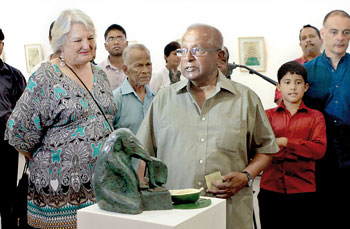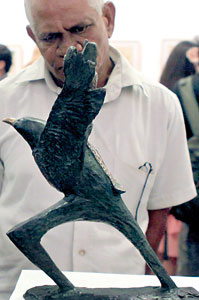Tissa Ranasinghe keeps his sculptures on a long, low table in his living room, shrouded in a white bed sheet. Under there, you will find the most unlikely companions – a faceless man astride a flying Garuda; a pair of lovers, entwined; a bull in a Red Indian head dress; the virtuous Kannagi and the determined Bhageeratha; the Buddha when he was but a boy; the Goddess of fire and others besides. They have all sprung from the sculptor’s imagination, frozen forever in mid-step, midflight, mid-kiss.
Now, hiding under the cloth, they eavesdrop on our conversation. “They keep getting smaller,” Tissa is saying, pointing at my voice recorder. “When I was young, journalists used to come to interview us with these large recorders. All the rubbish we used to spout into them...” Sounding faintly wistful, he continues, “You know, I’ve been a sculptor for 50 years now.”
 |
| His last exhibition in Colombo? Tissa with wife Sally at the opening on Thursday of the exhibits.
Pix by M.A. Pushpa Kumara |
Sri Lanka’s master sculptor is now a sprightly 86 years old – and though there is a slight tremble in his voice, he laughs often and long, and never misses the opportunity to exercise his wit. He is quick to point out that old age has brought him “backaches but not wisdom” and when he speaks of no longer being able to forge his own bronzes, it is with philosophical acceptance. After all, his body of work is impressive to say the least; always prolific, he created as many as 500 sculptures between 1963 and 1971 alone in a basic foundry on his brother’s coconut estate in the village of Yogiyana. “I have already spoilt my eyesight and my hearing,” he says indicating the little skin coloured aid nestled in his ear. “I used the machinery without earmuffs...I used to look directly in into the foundry, and it was like looking into the fires of hell. The glowing metal, it fascinated me.” It’s why he says, with a wry grin, that when he was still teaching, he would tell his students, “Do as I say, don’t do as I do.”
Bronze, a metal alloy made of tin and copper, has always bent to Tissa’s will. Flowing into characters and scenes out of myth and religion at his direction, it has been the medium of choice for much of his career. “Bronze lasts for generations,” he says. “I have one that will last longer than most of my other sculptures, I’m sure.” (The bronze sculpture 'Self Mortification' will remain undisturbed, sealed into the relic chamber of the Somawathiya Stupa.) While its persistence is a quality that appeals to him, he also delights in the alloy’s malleability and strength. “It can support a lot of weight,” he says, “It will take the impression of a fingerprint...It’s lovely...the touch and the feel of it.”
This fascination with texture is intrinsic to Tissa’s work. Sunlight streams down into the little patch of garden where we sit, but Tissa, in a moment of nostalgia, is telling me about nights long past when his young daughter would be admonished, told that if she did not go to bed, the ‘goni bila’ (a bogey man) would come for her. “She couldn’t say, ‘goni bila,’ she used to say, ‘gobi lala,’” he remembers. So, when he came across a piece of gunney sack, he knew what he wanted to do with it. He shows me the sculpture of a sinister figure, touched by yearning, peering into a window.
 |
“It means something personal,” he says, “and so I wanted to get the exact texture.” It is to do with what he calls the “pleasure of surfaces.” The figure is shapeless, but under my finger the arch of its back is ridged with lines that crisscross sharply. Sculptures, he believes are meant to be handled, to be hefted in your hand, to be viewed from all sides – “it’s different from every angle, it doesn’t mean the same thing either,” he says, adding that he is not averse to people picking up his sculpture, “just as long as you don’t chuck the thing on the floor.”
As an artist, it’s apparent that he does not cling to any sense of his own consequence (even though he is indisputably consequential, not only thanks to his wonderful portfolio, but in his legacy as a mentor to sculptors from all over the world). In his speech he is entirely self effacing, and refrains from profound meditations on his work.
“There’s no high faluting philosophy here,” he says, picking up the ‘gobi lala statue’. He expects critics will speak in terms of his “delving deep into his childhood psyche,” but says for him it is about creating “something you can touch, it’s very tactile.”
His new exhibition, on till this Wednesday, August 31 at the Lionel Wendt gallery will feature 14 of his new sculptures and a large number of sketches many of which date back to 1958 when a UNESCO travel grant allowed him to explore Italy and parts of France. “I didn’t have a camera and so I had to sketch. You didn’t have felt tip pens and the like then, so you had to use a bottle of ink, a steel nib and a pen.” There are also several nudes – “they always sell pretty well,” he grins.
Among the sculptures are the subjects of his long obsession – the Garuda, the androgyne and the lovers all stray into ambiguity. Tissa says he continues to be fascinated with the figure of a man blurring into a woman, where man and monster are two facets of the same being; the moment when the mortal is on the verge of godhood or where the god is made mortal by love or rage.
Delving into myth and religion, he is constantly reinventing these stories. While he is famous for his depictions of Prince Siddhartha, when he was “just an ordinary man trying to achieve enlightenment,” he says he has been tempted to sculpt the goddesses of the Hindu pantheon more than once. “I am fascinated by them,” he says. “Sometimes I think I am a Buddhist with a Hindu trying to get out of me. I have loved those legends for a long time now.”
Though he still creates the original plasters, Tissa no longer casts his own bronzes, preferring instead to send the plaster work directly to a foundry in Thailand where the actual casting is done. As if to echo the 1970s when times were hard for sculptors like himself, he says the price of bronze continues to rise.
This has prompted exhibitions of plasterwork for bronze, where viewers must imagine the end product. The cost of producing each sculpture is one reason why Tissa says he is still sometimes nervous before an exhibition – that and the irrational suspicion that “nobody will turn up.” Fortunately, unlike the Italian Renaissance sculptors he so admires, Tissa has chosen to have his life be about more than his work.
His wife, Sally, and he will celebrate their 49th anniversary this year and he says he wants a T-shirt that reads ‘if I had known grandchildren were so good, I would have had them earlier.’
In the meantime, he will be returning to London in September, having staged what he says might very well be his last exhibition in Sri Lanka. Still, his pièce de résistance remains uncast – “once you’ve done something perfect, you can’t go beyond that,” he says. Still the promise of that perfect sculpture gives him, and us, something to look forward to.
Tissa Ranasinghe’s Exhibition of bronze sculptures will be open to the public till August 31 at the Lionel Wendt from 10 a.m. to 7 p.m. daily. |



